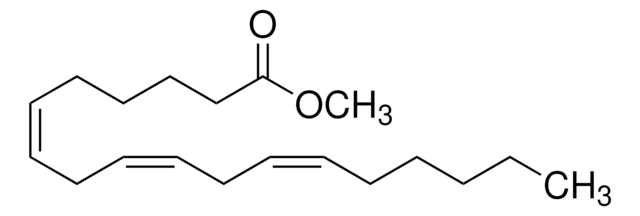Wichtige Dokumente
62280
Methyllinoleat
analytical standard
Synonym(e):
Methyl-cis,cis-9,12-octadecadienoat, Methyllinoleat
About This Item
Empfohlene Produkte
Qualität
analytical standard
Qualitätsniveau
Assay
≥98.0% (GC)
Haltbarkeit
limited shelf life, expiry date on the label
Methode(n)
HPLC: suitable
gas chromatography (GC): suitable
Brechungsindex
n20/D 1.462 (lit.)
n20/D 1.462
bp
192 °C/4 mmHg (lit.)
mp (Schmelzpunkt)
−35 °C (lit.)
Dichte
0.889 g/mL at 25 °C (lit.)
Format
neat
Funktionelle Gruppe
ester
Versandbedingung
ambient
Lagertemp.
2-8°C
SMILES String
CCCCC\C=C/C\C=C/CCCCCCCC(=O)OC
InChI
1S/C19H34O2/c1-3-4-5-6-7-8-9-10-11-12-13-14-15-16-17-18-19(20)21-2/h7-8,10-11H,3-6,9,12-18H2,1-2H3/b8-7-,11-10-
InChIKey
WTTJVINHCBCLGX-NQLNTKRDSA-N
Suchen Sie nach ähnlichen Produkten? Aufrufen Leitfaden zum Produktvergleich
Allgemeine Beschreibung
Anwendung
- Vergleichsanalyse von Gaschromatografie-Verbrennung-Massenspektrometrie- und Gaschromatografie-Flammenionisationsdetektor-Verfahren zum Bestimmen von Fettsäuremethylestern (FAME) in Biodieselproben
- Trennung und Quantifizierung von 16 Methyl- und Ethylfettsäureestern aus Biodieselproben auf Grundlage von Gaschromatografie-Tandem-Differenzialmobilitätsspektrometrie (DMS)
- Gleichzeitige Bestimmung von Fettsäuremethylestern in im Handel erhältlichen Speiseölproben mittels Gaschromatografie-Vakuum-Ultraviolett-Spektroskopie (GC-VUV)
- Messen der Fettsäuremethylesterzusammensetzung in verschiedenen Speiseölproben mittels 1H-Kernspinresonanz(1H-NMR)-Spektroskopie in Kombination mit einer Regression der partiellen kleinsten Quadrate (PLS)
- Analyse von Kaffeeöl und Rückständen aus gerösteten Kaffeebohnen zum Bestimmen der Zusammensetzung von 11 Fettsäuren nach ihrer Methylveresterung mittels an einen Flammenionisationsdetektor gekoppelter Gaschromatografie (GC-FID)
- Gleichzeitige Bestimmung von Fettsäuren in Rinderkolostrumproben mittels GC-FID nach ihrer Derivatisierung zu Esterformen unter Verwendung eines sauren Katalysators, Bortrifluorid
Sonstige Hinweise
Lagerklassenschlüssel
10 - Combustible liquids
WGK
WGK 1
Persönliche Schutzausrüstung
Eyeshields, Gloves
Hier finden Sie alle aktuellen Versionen:
Besitzen Sie dieses Produkt bereits?
In der Dokumentenbibliothek finden Sie die Dokumentation zu den Produkten, die Sie kürzlich erworben haben.
Kunden haben sich ebenfalls angesehen
Artikel
Separation of Methyl oleate; Caprylic acid; Heptanoic acid; Methyl decanoate; Methyl dodecanoate; Myristic acid; Methyl palmitate; Methyl palmitoleate; Methyl stearate; Methyl linoleate; Methyl linolenate; Acetic acid; Arachidic acid; Behenic acid; Propionic acid; Isobutyric acid; Valeric acid; Isovaleric acid; Isocaproic acid; Butyric acid
Protokolle
Separation of Methyl decanoate; Methyl dodecanoate; Methyl myristate; Methyl palmitate; Methyl caprylate; Methyl oleate; Methyl linoleate; Methyl linolenate; Methyl stearate
-11-eicosenoate; Methyl elaidate; Methyl linoleate; Methyl myristate; Methyl myristoleate; Methyl palmitate; Methyl palmitoleate; Methyl oleate; Methyl pentadecanoate; Methyl tridecanoate; Methyl behenate; Methyl caprylate; Methyl erucate; Methyl heptadecanoate; Methyl arachidate
gc-analysis-of-a-37-component-fame-mix-g004278
GC Analysis of a 37-Component FAME Mix on Omegawax® (15 m x 0.10 mm I.D., 0.10 μm), Fast GC Analysis
Unser Team von Wissenschaftlern verfügt über Erfahrung in allen Forschungsbereichen einschließlich Life Science, Materialwissenschaften, chemischer Synthese, Chromatographie, Analytik und vielen mehr..
Setzen Sie sich mit dem technischen Dienst in Verbindung.










